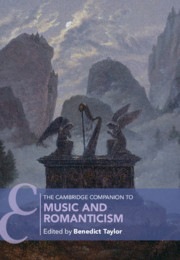Book contents
- The Cambridge Companion to Music and Romanticism
- Cambridge Companions to Music
- The Cambridge Companion to Music and Romanticism
- Copyright page
- Contents
- Figures
- Tables
- Musical Examples
- Contributors
- Preface
- Chronology
- Part I Horizons
- Part II Worlds
- Part III Aesthetics
- Part IV Practices
- Part V Histories
- Select Bibliography
- Index
- References
Part II - Worlds
Published online by Cambridge University Press: 06 August 2021
- The Cambridge Companion to Music and Romanticism
- Cambridge Companions to Music
- The Cambridge Companion to Music and Romanticism
- Copyright page
- Contents
- Figures
- Tables
- Musical Examples
- Contributors
- Preface
- Chronology
- Part I Horizons
- Part II Worlds
- Part III Aesthetics
- Part IV Practices
- Part V Histories
- Select Bibliography
- Index
- References
Summary

- Type
- Chapter
- Information
- The Cambridge Companion to Music and Romanticism , pp. 35 - 162Publisher: Cambridge University PressPrint publication year: 2021

